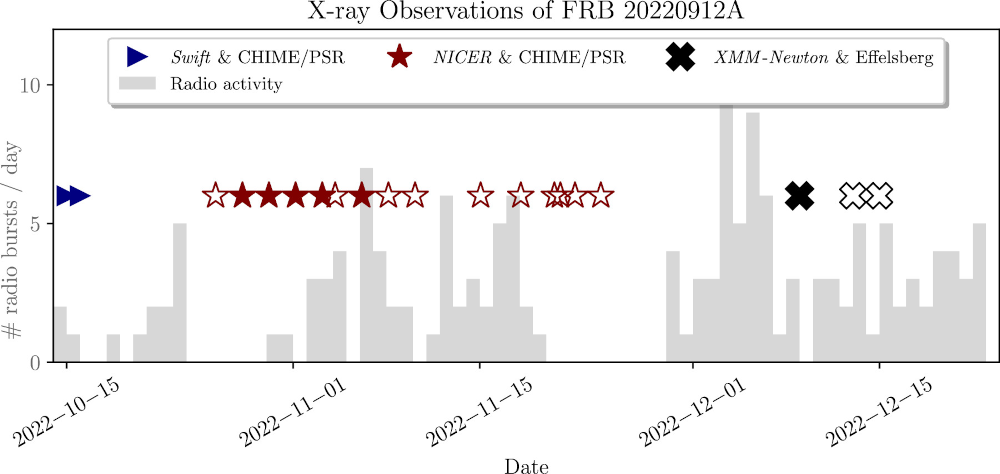NICER / ISS Science Nugget
for October 24, 2024
Do X-rays accompany fast radio bursts?
Among the denizens of the dynamic sky, the most fleeting and currently the most mysterious are fast radio bursts (FRBs), bright flashes that last milliseconds and have so far only been visible in the MHz-GHz radio band (wavelengths of tens to hundreds of centimeters). The vast majority of them appear to be completely unpredictable "one-off" events, which initially suggested that an FRB might represent the dying gasp of some cataclysmic event that destroys the host object, but the discovery of the first repeating FRB in 2016 put that notion to rest (at least for a subset of FRB sources - the repeaters now make up about 7% of the known population) and also paved the way for multiwavelength studies to help ascertain their origin, based on many published theories of simultaneous emission expected at much shorter wavelengths. Because the repeaters tend to exhibit bursts during limited periods of intense activity, the onset of one of these periods, or the discovery of a new repeater, triggers a flurry of activity with optical, X-ray, and other telescopes to attempt to detect simultaneous bursts at higher energies.
The Canadian Hydrogen Intensity Mapping Experiment (CHIME) in British Columbia, Canada, has proven to be a prolific facility for the study of FRBs. In 2022, its discovery of the repeater FRB 20220912A prompted a series of NICER observations to search for an X-ray counterpart. A peer-reviewed paper recently published in The Astrophysical Journal by A. Cook (Univ. of Toronto, Canada) and collaborators describes this effort: no X-ray bursts were seen, but the analysis sets the most stringent upper limit to date on the ratio of energy carried by any short-duration X-ray emission relative to radio, coincident or close in time. These limits begin to restrict models for FRB emission from some exotic classes of objects, while magnetar and neutron star origins remain viable; further simultaneous observations will put predictions for the latter to the test, especially as more-nearby FRB sources are simultaneously observed in both bands. Indeed, FRB investigations continue to be in high demand in the peer-reviewed proposals for telescope time that drive NICER's General Observer program.

NICER coverage of a source of fast radio bursts, soon after its discovery in 2022, enabled simultaneous radio/X-ray observations of 26 unique bursts, with NASA's Swift and ESA's XMM-Newton observatories contributing coverage of another 4 bursts. Open symbols represent X-ray observations during which no radio bursts - which occur at random times - were detected, while filled symbols represent successful X-ray coverage of at least one radio burst. (Credit: Cook et al. 2024)
<< Previous
Main Index
Next >>